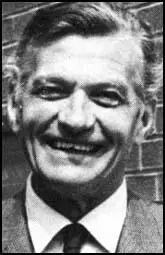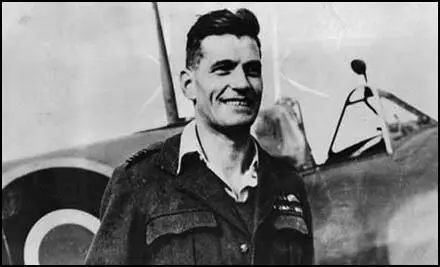Johnnie Johnson

James Edgar (Johnnie) Johnson was born at Barrow-upon-Soar, Leicestershire, England, on 9th March, 1915. He studied at Loughborough College and Nottingham University but after being rejected by the Royal Air Force he became a civil engineer.
Johnson was also initially rejected by the RAF Volunteer Reserve but they changed their mind after the outbreak of the Second World War. Selected for pilot training he was sent to Hawarden in Cheshire to learn to fly the Supermarine Spitfire.
In September, 1940, Johnson was posted to 19 Squadron but missed most of the Battle of Britain after being forced to have an operation on his shoulder. When he recovered he joined 616 Squadron where he flew Douglas Bader, Hugh Dundas and Jeff West.
Johnson soon emerged as an outstanding fighter pilot. A master of accurate deflection shooting, a skill he had developed as a child when he hunted rabbits with a shotgun. In September 1941 Johnson was promoted to flight lieutenant and was given command of B Flight.
In 1942 Johnson became squadron leader and in March 1943 was promoted to wing commander and given command of 610 Squadron. The following year he took over the Canadian wing in the recently formed 2nd Tactical Air Force.

By the end of the Second World War Johnson had flown in over 1,000 combat missions. He holds the remarkable record of never being shot down and on only one occasion was his Spitfire damaged by the enemy. Johnson has been credited with 38 kills. Officially this is the highest total of any RAF pilot but some experts believe that Marmaduke 'Pat' Pattle scored more than 40.
Johnson, who was awarded the DSO and two bars, the DFC and bar, the Legion d'Honneur and the Croix de Guerre, stayed in the Royal Air Force after the war. He served with the United States Air Force in the Korean War where he was awarded the American DFC.
In 1956 Johnson published his autobiography, Wing Leader. In 1960 Johnson was appointed senior air staff officer in 3 Group, Bomber Command. He eventually retired in 1966 as Air Officer Commanding, Air Forces Middle East in Aden.
James Edgar Johnson, who lived for a while in Jersey before retiring to Buxton, Derbyshire, died on 30th January, 2001.
Primary Sources
(1) Bill Gunston, The Guardian (1st February, 2001)
In 1937, Johnnie Johnson tried to join the Auxiliary Air Force (AAF). On hearing that he came from Melton Mowbray, Leicestershire, the interviewing officer said, "My dear chap, you've just the type. Which hunt do you follow?" When Johnnie said he did not even ride a horse, he was promptly shown the door. Little did that that interviewing officer think he had just rejected the man who, in the second world war, would shoot down more of the enemy than any other pilot in the RAF - and without ever being shot down himself.
(2) After the war the British fighter pilot Johnnie Johnson wrote about the merits of the Focke-Wulf 190.
The Focke-Wulf 190 was undoubtedly, the best German fighter. We were puzzled by the unfamiliar silhouette, for these new German fighters seemed to have squarer wingtips and more tapering fuselages than the Messerschmitts we usually encountered. We saw that the new aircraft had radial engines and a mixed armament of cannons and machine-guns, all firing from wing positions.
Whatever these strange fighters were, they gave us a hard time of it. They seemed to be faster in a zoom climb than the Me 109, and far more stable in a vertical dive. They also turned better. The first time we saw them we all had our work cut out to shake them off, and we lost several pilots.
Back at our fighter base and encouraged by our enthusiastic Intelligence Officers, we drew sketches and side views of this strange new aeroplane. We were all agreed that it was superior to the Me 109f and completely outclassed our Spitfire Vs. Our sketches disappeared into mysterious Intelligence channels and we heard no more of the matter,. But from then on, fighter pilots continually reported increasing numbers of these outstanding fighters over northern France.
(3) Johnnie Johnson later recorded how he was told to fit bombs onto his Supermarine Spitfire.
At this time the Spitfire IX was the best air fighter in the world. In my view it was not suitable for beating up the ground targets because its Merlin engine was cooled by a liquid called Glycol, which was held in a small tank just below the propellor. This Glycol tank and the radiator were always exposed to ground fire, at which the Germans were very adept. A single machine-gun bullet through either the radiator or the Glycol tank meant that the engine caught fire or seized up within a matter of a very few minutes. After four years of air fighting, and still remaining sound in wind and limb, the prospect of being shot down by a few rounds fired by some half-baked Kraut gunner did not appeal to me in the least!
The first time I saw my lean and graceful Spitfire with two 500 lb. bombs hanging beneath its slender wings, it seemed to me that she was intolerably burned, and that the ugly blunt bombs were a basic contradiction of all the beauty and symmetry of the aircraft. It was like seeing a beautiful racehorse harnessed to a farm cart.
(4) Christopher Foxley-Norris flew with Johnnie Johnson during the Second World War.
Johnnie Johnson's performance was even more creditable because he largely missed the Battle of Britain and won his "kills" in fighter-to-fighter combat rather than against heavy bombers. Johnnie's kills were hard-earned, but then Johnson had the two skills needed to be successful; he was a good shot and a good pilot. Lots of people were good pilots, but Johnnie was also a good shot - gifted in the art of deflection shooting.
(5) Johnnie Johnson, Wing Leader (1956)
It is fascinating to watch the reactions of the various pilots. They fall into two broad categories; those who are going out to shoot and those who secretly and desperately know they will be shot at, the hunters and the hunted. The majority of the pilots, once they have seen their name on the board, walk out to their Spitfires for a pre-flight check and for a word or two with their ground crews. They tie on their mae-wests, check their maps, study the weather forecast and have a last-minute chat with their leaders or wingmen. These are the hunters.
The hunted, that very small minority (although every squadron usually possessed at least one), turned to their escape kits and made quite sure that they were wearing the tunic with the silk maps sewn into a secret hiding-place; that they had at least one oilskin-covered packet of French francs, and two if possible; that they had a compass and a revolver and sometimes specially made clothes to assist their activities once they were shot down. When they went through these agonized preparations they reminded me of aged countrywomen meticulously checking their shopping- lists before catching the bus for the market town.
(6) Johnnie Johnson, Wing Leader (1956)
In the autumn of 1942, Wing Commander Jackie Darwin took over cornmand of 244 Wing, composed of two squadrons of Spitfires and two of Hurricanes. Darwin was a regular officer who before the war had served on the North-West Frontier of India and was also a keen follower to hounds. By a tragic misfortune he was dancing with his beautiful wife in the Cafe de Paris in London the night it was bombed, and she was killed in his arms. He never recovered fully from this shock, and developed a great hatred for the Germans and a complete disregard for his own safety. His pilots did not think much of flying next to him, for he always led them through the thickest of the flak, and whereas for sometime he bore a charmed life, his wingmen were not always so lucky.

